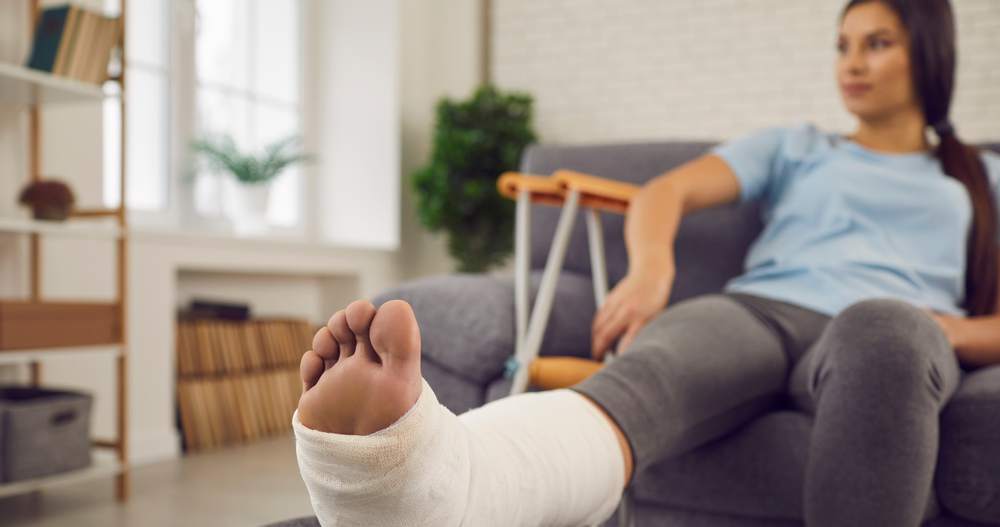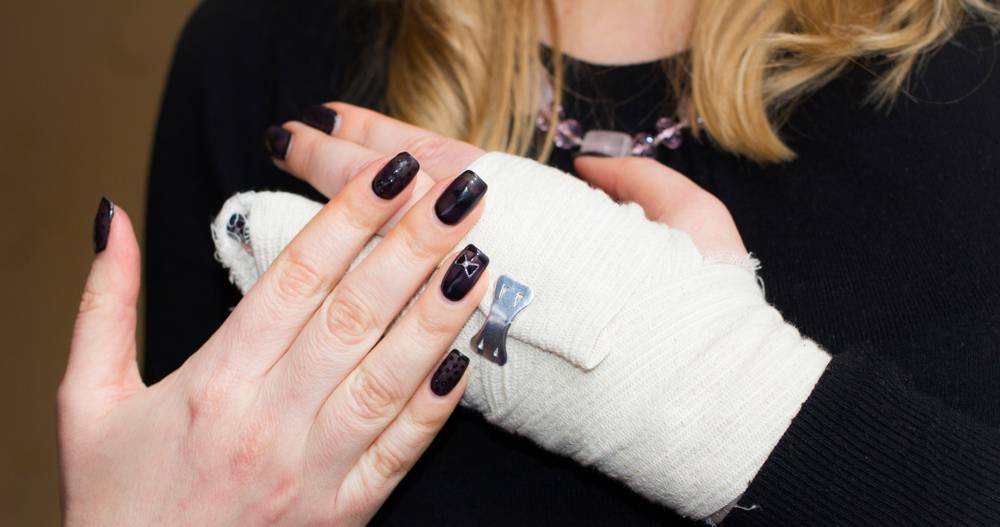 You or someone you know has probably broken a bone before. Whether you fell off the monkey bars as a child and broke your arm or a friend of yours suffered a broken leg after a car accident, you know these injuries are unfortunate but common. A broken bone is also known in the medical field as a fracture. A fracture can refer to a thin crack inside a bone or a bone that breaks into many pieces. The most common cause of a broken bone is sudden force or pressure. A fall onto outstretched hands or a blow to the leg could put too much pressure on a bone and cause it to break. Most of the time, you will experience significant pain and discomfort with a broken bone and go to the doctor. However, there are cases where you might not realize you have suffered a fracture. If you do suspect you have a fracture, you want to visit an orthopedic doctor right away. The best way to avoid complications from a broken bone is to get prompt medical treatment. You can also take steps in your daily life to help prevent broken bones. Here’s everything you need to know about the early treatment of fractures and how you can avoid issues with preventative measures.
You or someone you know has probably broken a bone before. Whether you fell off the monkey bars as a child and broke your arm or a friend of yours suffered a broken leg after a car accident, you know these injuries are unfortunate but common. A broken bone is also known in the medical field as a fracture. A fracture can refer to a thin crack inside a bone or a bone that breaks into many pieces. The most common cause of a broken bone is sudden force or pressure. A fall onto outstretched hands or a blow to the leg could put too much pressure on a bone and cause it to break. Most of the time, you will experience significant pain and discomfort with a broken bone and go to the doctor. However, there are cases where you might not realize you have suffered a fracture. If you do suspect you have a fracture, you want to visit an orthopedic doctor right away. The best way to avoid complications from a broken bone is to get prompt medical treatment. You can also take steps in your daily life to help prevent broken bones. Here’s everything you need to know about the early treatment of fractures and how you can avoid issues with preventative measures.
What Is a Bone Fracture?
You may recall what an X-ray looks like when someone has a broken bone, whether this has happened to you personally or you’ve seen it on tv or in the movies. People are most familiar with the idea of a broken bone that breaks cleanly and requires a brightly colored cast. However, with over 200 bones in the human body, there are so many ways you can break a bone and how it can impact you. You might think of a bone as something hard and solid when bones are actually porous and softer than you realize. Bones are made up of connective tissue with collagen, bone marrow, calcium, and specialized cells. In fact, you may be surprised to learn that blood cells are actually made inside of bone marrow! A bone is less like a solid steel rod and more like the branch of a tree. Bones are living, growing tissues that strengthen and harden with time and age. Your bones need to be strong and also have the flexibility to withstand the everyday stress and wear and tear on the body.
Types of Bone Fractures
 There are several different types of bone fractures, and they depend on the severity of the break and where the break occurs. Here are six examples of what type of bone fracture you may experience.
There are several different types of bone fractures, and they depend on the severity of the break and where the break occurs. Here are six examples of what type of bone fracture you may experience.
Closed vs. Open Fracture
A closed fracture is also known as a simple fracture. This is what most people think of when they hear the term ‘broken bone’ because the bone break occurs inside the body and does not break the skin. An open fracture, on the other hand, is also known as a compound fracture. With an open, or compound, fracture, one or more pieces of the broken bone actually pierce through the skin. When this happens, your bone and other internal tissues can become exposed, which increases your risk for infection.
Complete vs. Incomplete Fracture
A complete fracture refers to a complete break of the bone. The bone could snap or get crushed and breaks into two or more pieces. A single fracture refers to a type of complete fracture where the bone breaks into two pieces. An incomplete fracture means that the bone didn’t break all the way through. An incomplete fracture can still cause immense pain and discomfort.
Hairline Fracture
A hairline fracture is a type of incomplete fracture where a thin crack appears in the bone. While this may sound like a small issue, it can still cause a significant amount of pain. A hairline fracture, also known as a stress fracture, could develop because of repeated stress on the bone that leads to a bruise or small crack. A common example of a hairline fracture is a stress fracture in the foot that can affect runners. Repeated force on the foot, like hitting the pavement over and over again, can lead to swelling and pain along with tiny cracks along the surface of one or more bones in the foot.
Greenstick Fracture
A greenstick fracture is a type of incomplete fracture where the bone bends and cracks but doesn’t break into separate pieces. This type of break gets its name from when you try to break a small, green branch on a tree. When you put pressure on a newly developing tree branch that’s still green and new, it may bend and one side cracks but doesn’t break all the way through. Greenstick fractures require immobilization with a cast during the healing process to help prevent the bone from breaking completely through.
Buckle Fracture
A buckle fracture, also known as a torus fracture, is another type of incomplete fracture where one side of the bone breaks and the other side develops a bump, as if the structure has ‘buckled’ under pressure. A buckle fracture is a common fracture that occurs in children and happens when too much pressure or compression on one side of the bone, causing it to crumple. Adults do not get buckle fractures because their bones are less elastic than children’s developing bones.
Displaced Fracture
A displaced fracture refers to when a bone breaks and the pieces move out of alignment. This type of fracture can require surgery because the bones need to be moved back into place. That’s because when a displaced fracture occurs, the pieces of the broken bone no longer line up correctly, and a gap may even form where the break occurred.
Broken Bones in Children vs. Adults
Children have softer bones than adults because their bones are still developing. Once you reach adulthood, your bones become stronger but also more brittle with age. That is why children are more likely to suffer an incomplete fracture than an adult. Children’s bones can also withstand greater pressure like a force that leads to the bone deforming instead of simply breaking all the way through. Just like the twigs and branches on a tree, children’s bones are more like soft, green, new growths, while adult bones are like older branches and sticks that can snap or break easier. Children’s bones also heal faster from a fracture than adult bones do. That’s because children’s bones are softer and more flexible than adult bones. But just because their bones are softer doesn’t mean they’re weak. In fact, children’s bones are stronger than adult bones! Health conditions like osteoporosis that develop in older adults can also make adult bones even more brittle and susceptible to injury.
Risk Factors for Broken Bones
While it is totally possible, and even common, for children to break a bone, they typically recover a lot faster than adults. Because of a child’s ability to bounce back, a bone fracture doesn’t have long-lasting effects like it would for an adult. Older adults are at greater risk for a fracture, which can also come with complications. Adult bones take longer to heal after a fracture, and a period of immobility can cause your muscles and other nearby tissues to become weakened, impacting your overall strength and mobility. Adults who have osteoporosis or intestinal disorders are also at greater risk for a fracture or broken bone. People who are physically inactive are at risk for a fracture because a more sedentary lifestyle can leave you with less strength, coordination, and balance, therefore more susceptible to falls or other injuries. People who smoke or drink alcohol are also at greater risk for broken bones because these have a negative impact on bone density and calcium absorption in the body.
Treating a Bone Fracture
 The specific treatment for your bone fracture will depend on the type and location of the break. Here are a few examples of common treatment options for different types of broken bones.
The specific treatment for your bone fracture will depend on the type and location of the break. Here are a few examples of common treatment options for different types of broken bones.
Immobilization
The first thing to do with a broken bone is to immobilize the area. In order to get the bone back into its proper position and allow for healing, the bone needs to stay immobile. This typically means you will need to restrict movements of the affected area. For example, if you break your arm, your doctor may utilize a splint that fits snugly around your arm both above and below the break. In some cases, the doctor may need to immobilize a nearby joint that connects to the area where the fracture occurred to ensure the bone can heal safely.
Alignment
Depending on the type of fracture, your doctor will need to put the pieces of the broken bone back into their proper places. A way to realign the bone without surgery is known as a closed reduction. This type of nonoperative treatment involves your doctor manipulating the pieces back to their proper alignment and typically takes place shortly after the injury occurs. Another way to realign the bone is known as traction, where the doctor stretches muscles and tendons around the broken bone with a system of pulleys and weights.
Stabilization
You may get a cast around the broken bone to help stabilize the area during the healing process. A cast not only helps immobilize the area but also helps hold the bone fragments in place so that when the bone heals, it also realigns properly. Special bracing may also be used to stabilize a fracture. Traction may also be used to stabilize a fracture and could be used as a temporary method before you get surgery for a broken bone.
Surgery
Sometimes a broken bone cannot be treated with nonoperative measures and surgery is needed. An open reduction refers to a surgical procedure where the fragments of the broken bone are realigned in surgery. A surgeon may use pins, rods, and other medical pieces made of metal or plastic to help stabilize the bone and keep the bones from moving. Sometimes these pieces stay inside, while others may be positioned on the outside and removed after you’ve healed. Two types of surgery for a fracture include internal fixation and external fixation.
Physical Therapy
After a broken bone, you may need physical therapy to help you regain strength and mobility. Because a fracture typically requires a period of immobilization, nearby muscles and other tissues may weaken and you may lose some range of motion. A physical therapist can help you strengthen supportive tissues and improve your range of motion with a series of stretches and exercises that target the area. Physical therapy can also help you recover from surgery by ensuring you reintroduce movements and activities safely. You can also work with your physical therapist to manage pain and discomfort through the recovery and rehabilitation process. Your age and physical fitness can impact your length of recovery from an injury like a broken bone. A physical therapist can help you improve your overall health and wellness while addressing your recovery from a bone fracture.
Preventing Future Bone Fractures
Early treatment and prevention are both vital for a swift recovery from a bone fracture. To prevent bone fractures, you can take small steps in your daily life to improve the health of your bones and reduce your risk for injury:
- Get enough calcium and daily vitamins
- Engage in regular exercise
- Get an osteoporosis evaluation
- Treat health conditions promptly
- Remove obstacles in your home that could cause a fall
Visit AICA Orthopedics to learn more about how you can prevent fractures and get started on treatment for a fracture as soon as possible. Our team of doctors includes orthopedic surgeons, chiropractors, and physical therapists who can diagnose your type of bone fracture and get you set up with a personalized treatment plan to help you recover and rehabilitate swiftly and safely. Our doctors work together to provide you with comprehensive care and support while you heal from a broken bone.
